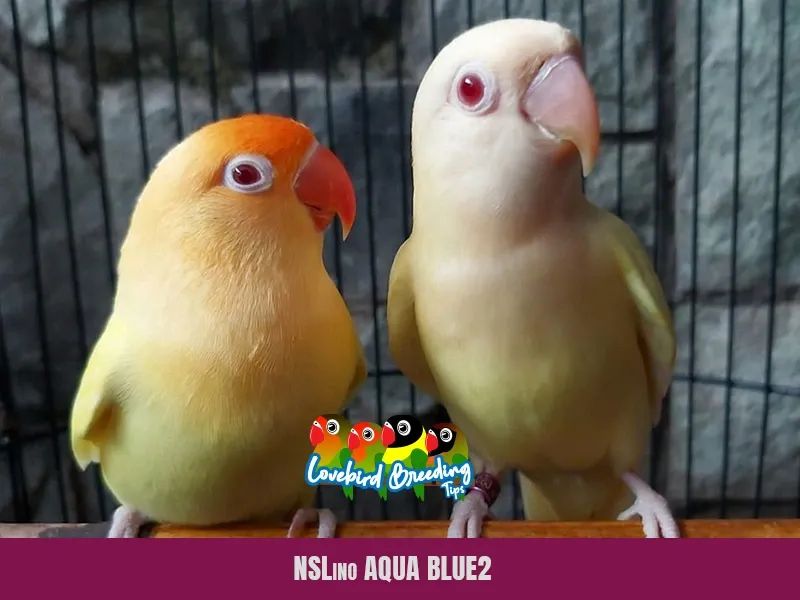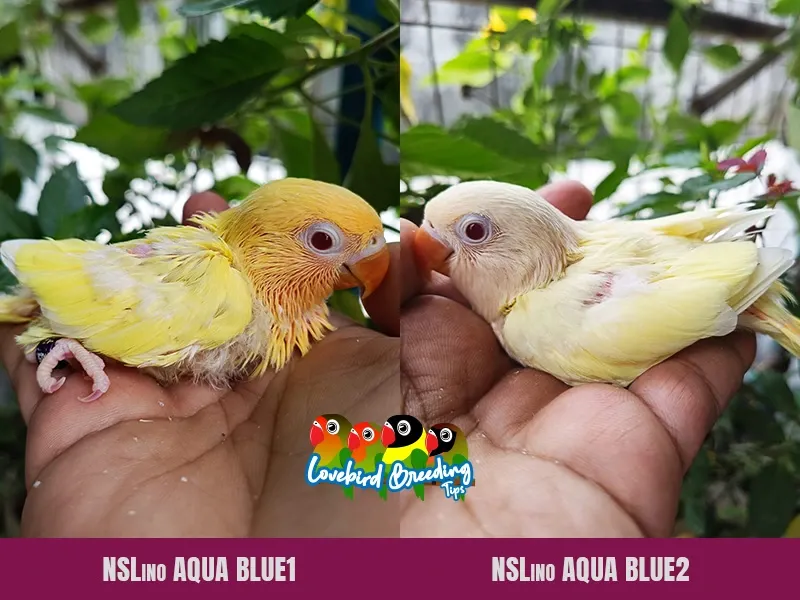
NSL ino aqua is the combined phenotype of a cross between Aqua Mutations X NSL ino lovebirds. Each mutation in the lovebirds has a different version of albinism. Lutino for NSL ino green, Albino for NSLino blue, and Creamino for NSL ino blue1blue2/parblue.
Uniqueness occurs in the aqua mutation because NSL ino aqua has two types. Perhaps it can be referred to as NSL ino aqua blue1 and NSL ino aqua Blue2.
Because the basis is indeed the two mutations that I discussed earlier. It is not just a naming exercise; the phenotypic differences occur between the two types of NSL ino aqua.
Table of Contents
Characteristics of NSL ino Aqua blue1 and blue2 lovebirds mutation
Let's learn the characteristics of the Fischeri NSL ino Aqua lovebird, from the color of the body feathers, beak, mask, and tail, to the way of genetic inheritance.NSL ino Aqua blue1

I call this bird the lutino-bodied but aqua-headed parblue. Because the NSL ino aqua blue1 indeed has a very intensive orange mask or head area that resembles a lutino but tends to be paler.
The beak color on the NSL ino aqua blue1 lovebirds is also identical to blue1blue2/parblue with a yellowish orange color.
The color of the tail pattern of NSL ino aqua blue1 is an intensive orange that matches the color of the mask/head feathers. This is even more evident when NSL ino aqua combines with Opaline /Opaline NSL ino Aqua blue1.
The outer vane color on the NSL ino aqua blue1 is identical to what is seen on the Lutino. The background is white, with a yellow hue on each edge.
NSL ino Aqua blue2

People usually call it NSL ino the white face because the mask color of this NSL ino, aqua blue2, is white with a reddish cream background on a white background.
There are also two variants for the fur color on the body. Full yellow like a lutino and a cream identical to a creamino. The color of the tail pattern is, of course, in line with the color of the fur on the head.
The beak color of the NSL ino aqua blue2 is ivory white, just like the blue1/blue series.
From the summary of several sources and the results of the acquisition at the aviary, I concluded that the differences in the characteristics of the two types of NSLino aqua were due to their predecessors.
If you pair aqua with lutino/blue, you will likely get type 1. While type 2 is obtained from a cross between aqua x albino/NSL ino blue. It is also possible from an Aqua x Albino cross phenotypically, but genotypically, the albino is a blue2 albino.
That's not an absolute if you're working with a bird from now here whose pedigree is still being determined.




Because the aqua phenotype is very much a visual shift. Even from the 2 types I mentioned above, several different phenotypes still exist.
I will publish it in a separate article in the future.
